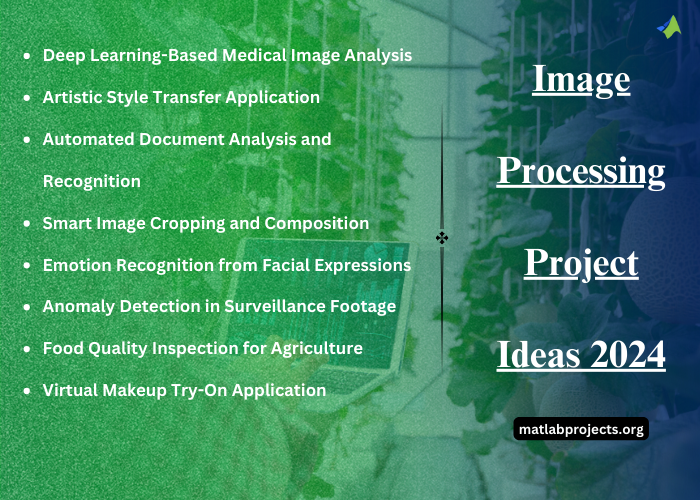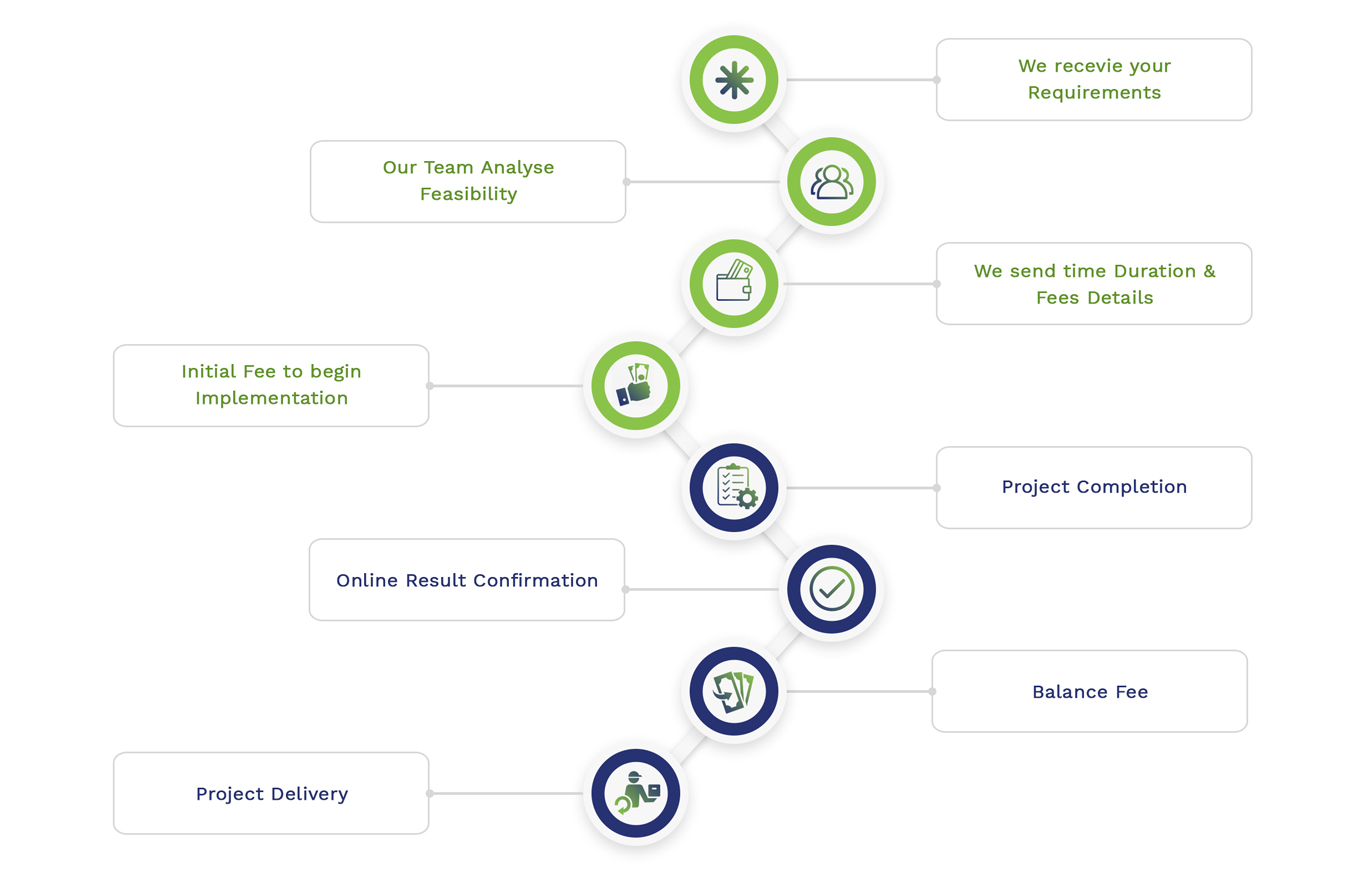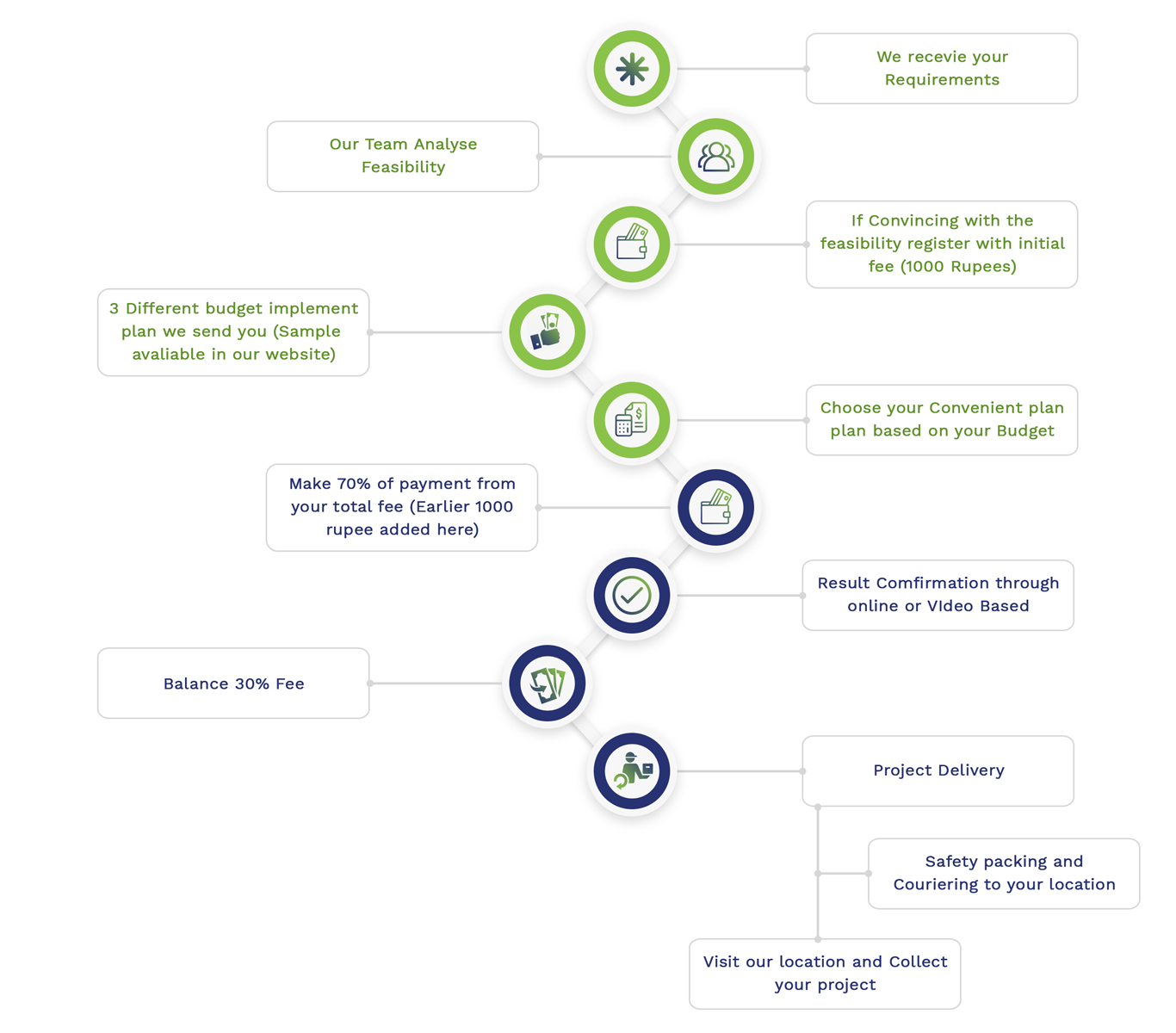Image processing is a set of methods which is utilized for transforming the image to digital form for acquiring beneficial details. Reflecting on promising research areas in image processing, some of the intriguing and noteworthy research topics are suggested here:
- Deep Learning-Based Medical Image Analysis:
- For medical image analysis like lesion segmentation in histopathology images or tumor detection in MRI scans, design a machine learning model. For advanced authenticity and capability, investigate the upgraded systems.
- Artistic Style Transfer Application:
- By using neural style transfer methods, implement artistic styles from prevalent paintings to their photos through modeling an application which enables the users. Considering personalization, it offers visual controls and executes real-time style transfer.
- Automated Document Analysis and Recognition:
- Specifically for document analysis and recognition in an automated manner, develop a system and from camera images or scanned documents, it must have the capacity to derive diagrams, text and tables. To interpret the document, include computer vision techniques and OCR (Optical Character recognition).
- Smart Image Cropping and Composition:
- Depending on content analysis and visual principles, recommend perfect crop areas and blueprints automatically by creating a smart image cropping and composition tool. As a means to interpret from user reviews and priorities, deploy machine learning frameworks.
- Wildlife Monitoring and Conservation:
- Examine camera trap images and identify track activities, animal species and population figures through generating a wildlife monitoring system with the help of image processing methods. For activity assessment and category recognition, apply efficient techniques.
- Emotion Recognition from Facial Expressions:
- From facial expressions which are captured in videos or images, construct a model for realizing up-to-the-minute emotions. To identify and categorize emotions like surprise, sadness, anger and joy, prepare with deep learning algorithms.
- Anomaly Detection in Surveillance Footage:
- In order to detect the questionable scenarios or activities in crowded events, create an anomaly detection system for surveillance footage. Identify differences and interpret basic behavior patterns through implementing unsupervised learning methods.
- Food Quality Inspection for Agriculture:
- To identify diseases, injuries or drawbacks in evaluating the images of fruits and vegetables, employ image processing to develop a food quality inspection system for agriculture. For automated quality evaluation, execute machine learning algorithms.
- Virtual Makeup Try-On Application:
- Apply image processing and AR (Augmented Reality) to develop virtual makeup try-on applications which visualize various makeup products on their faces by accessing the users. To detect facial characteristics and makeup description precisely, create effective methods.
- Gesture Recognition for Human-Computer Interaction:
- For the purpose of communication between human and computer, model a gesture recognition system and through camera images or depth sensors, it should be feasible to realize poses and hand signals. For gesture categorization and management, execute machine learning models.
How to write MATLAB code for image processing?
While you are writing a MATLAB code for image processing, you must follow certain procedures to execute your program without any errors. We offer a simple overview in what way you have to write a MATLAB code for image processing:
Step 1: Load an Image
- To read an image from a file into MATLAB, make use of the imread function. Define the filename as an argument and image is loaded into a matrix by means of MATLAB.
% Load an image
Img = imread (‘example_image.jpg’);
Step 2: Preprocess the Image (Optional):
- According to the particular task, it is necessary to involve improving contrast, resizing or converting to grayscale in this preprocessing. For this process, utilize functions such as histeq, imresize and rgb2gray.
% Convert to grayscale
gray_img = rgb2gray (img);
Step 3: Perform Image Processing Tasks:
- By using MATLAB functions, execute the required image processing techniques. In accordance with your application, it might encompass feature extraction, filtering, segmentation or other specific properties.
% Apply a median filter for noise removal
filtered_img = medfilt2 (gray_img);
Step 4: Visualize or Save the Results:
- Utilize imshow function to exhibit the processed image or implement imwrite function to save it in file. For analysis or display objectives, you can include illustrations or comments on the image.
% Display the processed image
Imshow (filtered_img);
% Save the processed image to a file
Imwrite (filtered_img, ‘processed_image.jpg’);
Step 5: Iterate and Refine (Optional):
In order to enhance the findings, reiterate your code, approach diverse techniques or modify the parameters. For instant prototyping and practicals, MATLAB’s interactive platforms access the users.
For the purpose of image processing by considering where we load an image, transforming into a grayscale and implement a median filter, we offer a sample MATLAB code:
% Load an image
Img = imread (‘example_image.jpg’);
% Convert to grayscale
gray_img = rgb2gray (img);
% Apply a median filter for noise removal
filtered_img = medfilt2 (gray_img);
% Display the processed image
Imshow (filtered_img);
% Save the processed image to a file
Imwrite (filtered_img, ‘processed_image.jpg’);
Which is better for image processing ,MATLAB or Python?
For image processing, both MATLAB and Python play a significant role. Even though, it has some contradictions while comparing their particular performance. To clarify this, we discuss both benefits and drawbacks of MATLAB and Python:
MATLAB for Image Processing:
Advantages:
- Built-in Functions: Especially for image processing, MATLAB is tailored which is beneficial in carrying out the general task in a simple format. MATLAB provides an extensive set of built-in procedures and toolkits.
- Interactive Environment: Considering the preliminary examination and progress, MATLAB’s interactive platform is highly relevant which enables users for instant prototyping and exploration.
- Matlab Image Processing Toolbox: For the process of simplifying the evolving process, feature extraction, image advancement, segmentation, filtering and other specifics, the MATLAB image processing toolbox offers an extensive range of techniques.
- Documentation and Assistance: To seek assistance and interpret the process of how to implement image processing capacities, MATLAB offers various online sources by detailed documentation.
Dis-Advantages:
- Commercial Software: You have to buy a license for the MATLAB application, as it is commercial software. Regarding the firms or individuals with budget shortfalls, it is a crucial obstacle.
- Performance: Particularly when handling complicated algorithms or big data, MATLAB might not be productive for highly demanding tasks compared to Python.
- Small-scale Integration: In opposition to Python, MATLAB is confined to application in specific systems as it synthesizes partially with other software environments and tools.
Python for Image Processing (with libraries like OpenCV, scikit-image, and NumPy):
Advantages:
- Open-Source: For the broader public, python is highly available and it is an open-source which is more easily accessible. It is prevalent for its affordable cost, as they do not need licensing fees.
- Community and Ecosystem: Considering the image processing, it gives rise to a huge ecosystem of libraries and tools, as python contains extensive and dynamic community developers. For different image processing tasks, it provides libraries such as NumPy, scikit-image and OpenCV.
- Portability and Adaptability: Across image processing, python is applicable in a great diversity of applications for its portability and adaptability. Python allows for smooth workflow integration and effectively synthesizes with other libraries and settings.
- Performance: Regarding rapid image processing operations, python performance could be advanced by deploying libraries such as OpenCV and for numerical calculations, using NumPy. For powerful computing tasks, it makes python more adaptable.
Dis-Advantages:
- Learning Period: Particularly the users those who are having little experience or beginner to programming, Python is a challenging learning curve in contrast to m compared to M
- Documentation Quality: In the process of seeking related data, it demands extra effort due to the variation of capacity and coherence among tools and libraries, as Python contains huge files and sources.
- Development Platform: In contrast to MATLAB’s integrated platform, Python involves high efforts in configuring programming settings for Python which involves processing the installation and handling the requirements.

Image Processing Project Topics 2024
Latest Image Processing Project Topics based on 2024 concepts that we worked are shared below. Stay tuned for more updates on Image Processing we will provide you with good services and keep you updated on your work. We will provide customized topics for both undergraduate and postgraduate students based on their individual requirements.
- An Entropy Interpretation of the Logarithmic Image Processing Model With Application to Contrast Enhancement
- An Automatic Nuclei Cells Counting Approach Using Effective Image Processing Methods
- The application of multimedia image processing technology in the reconstruction of Hainan Li brocade Images
- An image processing scheme to quantitatively extract and validate hyoid bone motion based on real-time ultrasound recordings of swallowing
- All-IDB: The acute lymphoblastic leukemia image database for image processing
- Digital image processing methods in biological structure recognition – a short review
- Cluster-based probability model and its application to image and texture processing
- New image processing challenges for jointly designed electro-optical imaging systems
- A new approach to image processing in diffuse optical tomography and 3-D image
- Performance prediction for parallel reconfigurable low-level image processing
- Real-time image acquisition and processing system design based on DSP
- Image-processing approach via nonlinear image-decomposition for a digital color camera
- ResGAN: A Low-Level Image Processing Network to Restore Original Quality of JPEG Compressed Images
- Research on Fire Detection and Image Information Processing System Based on Image Processing
- Hybrid perceptual image processing using new interpolating wavelets
- An automated image processing system for the detection of photoreceptor cells in adaptive optics retinal images
- hree-Dimensional Reconstruction and Image Processing in Mandibular Distraction Planning
- TGenetic-based fuzzy image filter and its application to image processing
- Digital mammography texture analysis by computer assisted image processing
- Coherent Multiscale Image Processing Using Dual-Tree Quaternion Wavelets
- Effects of different varieties and shelf storage conditions of chicory on deteriorative color changes using digital image processing and analysis
- Application of digital image processing techniques for asphalt concrete mixture images
- The correlation between aggregate shape and compressive strength of concrete: Digital image processing approach
- Elimination of autofluorescence in immunofluorescence microscopy with digital image processing.
- A comparison between the sampling Kantorovich algorithm for digital image processing with some interpolation and quasi-interpolation methods
- Application of digital image processing to detect short-circuit turns in power transformers using frequency response analysis
- Online quality optimization of the injection molding process via digital image processing and model-free optimization
- Automatic correction of lens distortion by using digital image processing
- Use of a scanner and digital image-processing software for the quantification of adsorbed substances
- Improvements in blast fragmentation models using digital image processing
- Burden distribution analysis by digital image processing in a scale model of a blast furnace shaft
- Correlation between shape of aggregate and mechanical properties of asphalt concrete: Digital image processing approach
- The influence of filling technique on depth of tubule penetration by root canal sealer: a study using light microscopy and digital image processing
- Automated counting of off-axis tunnelling cracks using digital image processing
- Coal flame characterization by means of digital image processing in a semi-industrial scale PF swirl burner
- Digital image processing versus visual assessment of chewed two‐colour wax in mixing ability tests
- Unmanned aerial vehicle (UAV)-powered concrete crack detection based on digital image processing
- Application of 3D laser scanner, optical transducers and digital image processing techniques in physical modelling of mining-related strata movement
- Measurement of shock wave unsteadiness using a high-speed schlieren system and digital image processing
- Computer-aided diagnosis of solid breast nodules on ultrasound with digital image processing and artificial neural network
- Polarized light microscopy and digital image processing identify a multilaminar structure of the hamster zona pellucida.
- Asphalt internal structure characterization with X-ray computed tomography and digital image processing
- Quantifying geomembrane wrinkles using aerial photography and digital image processing
- Defect detection and quantification system to support subjective visual quality inspection via a digital image processing: A tiling work case study
- Impact resistance, microstructures and digital image processing on self-compacting concrete with hooked end and crimped steel fiber
- Acoustic species identification in the Northwest Atlantic using digital image processing
- Detecting incipient radial deformations of power transformer windings using polar plot and digital image processing
- Quantitation of specific parameters of motility in large numbers of human sperm by digital image processing
- Measurement of fiber orientation in short‐fiber composites using digital image processing
- Development and evaluation of an automatic acne lesion detection program using digital image processing
- Development control parking access using techniques digital image processing and applied computational intelligence
- Lignocellulosic biomass particle shape and size distribution analysis using digital image processing for pipeline hydro-transportation
- Experimental determination of crack-bridging constitutive relations of hybrid-fiber Strain-Hardening Cementitious Composites using digital image processing
- Vibration measurement using phase shifting TV-holography and digital image processing
- Automated recognition of surface defects using digital color image processing
- Review of different local and global contrast enhancement techniques for a digital image
- The study of island growth of ion beam sputtered metal films by digital image processing
- IBIS: A geographic information system based on digital image processing and image raster data type
- Digital image processing techniques, fractal dimensionality and scale-space applied to surface roughness
- Quantitation of coronary artery dimensions using digital image processing
Subscribe Our Youtube Channel
You can Watch all Subjects Matlab & Simulink latest Innovative Project Results
Our services
We want to support Uncompromise Matlab service for all your Requirements Our Reseachers and Technical team keep update the technology for all subjects ,We assure We Meet out Your Needs.
Our Services
- Matlab Research Paper Help
- Matlab assignment help
- Matlab Project Help
- Matlab Homework Help
- Simulink assignment help
- Simulink Project Help
- Simulink Homework Help
- Matlab Research Paper Help
- NS3 Research Paper Help
- Omnet++ Research Paper Help
Our Benefits
- Customised Matlab Assignments
- Global Assignment Knowledge
- Best Assignment Writers
- Certified Matlab Trainers
- Experienced Matlab Developers
- Over 400k+ Satisfied Students
- Ontime support
- Best Price Guarantee
- Plagiarism Free Work
- Correct Citations
Expert Matlab services just 1-click

Delivery Materials
Unlimited support we offer you
For better understanding purpose we provide following Materials for all Kind of Research & Assignment & Homework service.
 Programs
Programs Designs
Designs Simulations
Simulations Results
Results Graphs
Graphs Result snapshot
Result snapshot Video Tutorial
Video Tutorial Instructions Profile
Instructions Profile  Sofware Install Guide
Sofware Install Guide Execution Guidance
Execution Guidance  Explanations
Explanations Implement Plan
Implement Plan
Matlab Projects
Matlab projects innovators has laid our steps in all dimension related to math works.Our concern support matlab projects for more than 10 years.Many Research scholars are benefited by our matlab projects service.We are trusted institution who supplies matlab projects for many universities and colleges.
Reasons to choose Matlab Projects .org???
Our Service are widely utilized by Research centers.More than 5000+ Projects & Thesis has been provided by us to Students & Research Scholars. All current mathworks software versions are being updated by us.
Our concern has provided the required solution for all the above mention technical problems required by clients with best Customer Support.
- Novel Idea
- Ontime Delivery
- Best Prices
- Unique Work
Simulation Projects Workflow

Embedded Projects Workflow



 Matlab
Matlab Simulink
Simulink NS3
NS3 OMNET++
OMNET++ COOJA
COOJA CONTIKI OS
CONTIKI OS NS2
NS2






